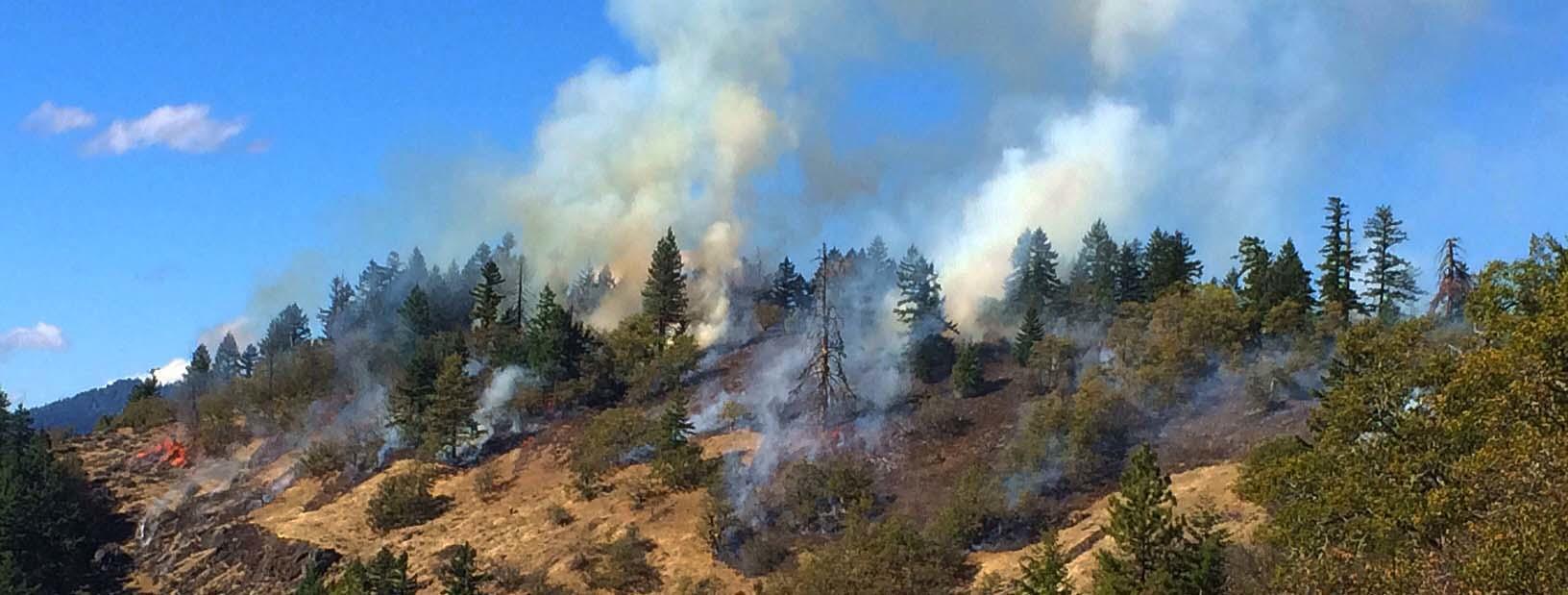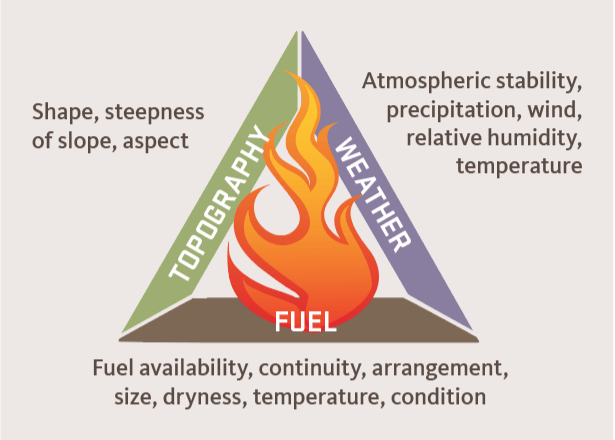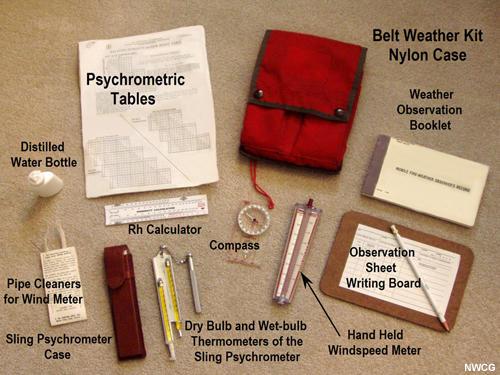Weather is critical to our understanding of prescribed fire. As one of the pillars of what we call the “fire behavior triangle,” weather — along with topography and fuels — affects nearly every aspect of a prescribed burn.You can think of weather as both:
A tool for helping achieve the desired objectives of a prescribed burn, and
A risk factor that can cause consequences, such as smoke impacting vulnerable communities or an escape.
Weather is a matter of safety for those staffing the burn and the public. Understanding fire weather helps practitioners manage smoke and comply with regulations.
Climate change is impacting fire weather and fuel conditions that affect prescribed burning. As our climate warms, fire weather becomes a larger factor in the practice of prescribed burning. Climate extremes affect not only weather but also fuels, compounding the impact.
What is fire weather?
Fire weather is a set of meteorological conditions that influence opportunities for fire behavior and smoke dispersion and development. Key aspects of fire weather include:
- Scale — the size of a weather system, the duration of a weather pattern.
- Atmospheric processes — moisture in the air, atmospheric stability, warming and cooling, wind speed and direction.
- Air masses — their movement and the boundaries between them; high or low pressure; warm or cold; moist or dry.
- Topography and landscape — aspect, slope, elevation. How terrain and weather interact.
These aspects affect the likelihood of a fire starting, a fire’s behavior and the level of difficulty in managing a fire. Is fire behavior matching the objectives of the burn? Is smoke affecting at-risk communities?
How does fire weather factor into a prescribed burn?
Seasonality influences the effects of fire. Wildfires in the West are strongly seasonal; 94% of fires and 98% of areas burn between May and October. In the Pacific Northwest, prescribed burn managers usually burn before or after the fire season, in spring or fall. High fuel moisture typically prevents burning during winter. Summer temperatures and humidity can lower fuel moisture, which increases fire behavior and decreases predictability, leading to unintended impacts.
Daily fluctuations in weather also influence the effects of fire. If critical weather is possible, fire managers monitor, record and communicate weather conditions every hour, during the burn and afterwards.
Prescribed burn managers consider prior conditions, including drought, precipitation and monthly temperature extremes, in planning a burn. Table 1 lists the weather elements managers consider when planning for a prescribed burn.
Temperature
Changes in air temperature influence fire behavior. High temperatures can contribute to extreme fire behavior by drying and preheating fuels. The objectives of a prescribed fire and the fuel type (grass, shrubs, trees, etc.) determine the acceptable range of temperatures for a burn.
Relative humidity
Relative humidity, or RH, is a ratio of the amount of water vapor actually evaporated into the air compared to the maximum amount possible. High RH reduces the chance of successful ignition of prescribed fire. Moisture in air and fuels inhibits fire.
Different fuel types require specific RH ranges to combust. Prescribed burners can conduct burns outside that range depending on fuels, objectives and forecasts for changes in RH during the burn. Fires are easier to control when RH is neither too high nor too low. As RH increases, many fine fuels like grasses may not ignite. A patchy burn may result.
Burning when relative humidity is low could create unsafe and difficult conditions. This is because fuel moisture — especially in fine fuels — dries out quickly. Fires can easily ignite and spread fast. This is especially true if temperatures are high. Burn managers may cancel or postpone a prescribed fire if the RH falls outside of maximum and minimum thresholds.
Wind speed and direction
Wind plays a major role in fire behavior. Wind can carry heat from a fire into unburned fuels, preheating, drying and possibly igniting them. When wind direction aligns with terrain to form downslope winds, air compresses and expands. Fuels dry out, and dry conditions can extend into the night and can keep overnight relative humidity low. This leads to extended burn periods. High winds increase the rate of fire spread on the ground. Winds stoke the fire, increasing the oxygen available to the fire and the rate of combustion. They also increase flame length, which can lead to torching and crown fires. Strong winds can sustain large crown fires and carry embers far outside the burn unit perimeter. This can compromise fire lines. A relatively sudden and major change in wind direction can quickly turn a fire flank into a wide head fire.
A gust of wind is a brief increase in the speed of the wind, usually for a period of less than 20 seconds. But this sudden increase in wind speed can greatly impact fire behavior and lead to fire spread. Passes, saddles, gorges, canyons and ravines create a path for wind to funnel and speed up. Burn managers should consider these topographic features during planning.
A light wind can also move fire in a desired direction and dissipate rising heat. This reduces heat damage to trees’ foliage. Wind speed and direction can also affect smoke dispersal and impact nearby communities.
Avoid prescribed fire during any wind advisory or Red Flag Warning. Warm temperatures, low humidity and strong winds raise the risk of escape.
Precipitation
Precipitation affects the moisture levels of live and dead fuel. Too much precipitation can inhibit ignition and make it difficult to sustain a burn. Too little precipitation creates drought stress that could lead to extreme fire behavior. Managers can consult an array of resources when timing a burn. These include: the U.S. Drought Monitor, Palmer Drought Severity Index, Evaporative Drought Demand Index, National Fire Danger Rating System, local fuel moisture sampling and the National Fuel Moisture Database.
Clouds
Clouds block solar radiation from reaching the surface during the day. They can also diminish heat loss at night. The presence of clouds can affect air temperature as well as live and dead fuel temperature. In addition, some cloud types can forewarn of critical fire weather conditions, such as thunderstorms, strong mountain winds that flow downslope and sea breeze fronts. Critical cloud signs can alert burn managers to potential changes in weather and fire behavior.
Atmospheric stability
Atmospheric stability is a characterization of the tendency for vertical motion of air. An unstable atmosphere promotes vertical motion, with air both rising and falling. A parcel of air that’s warmer than its environment tends to rise, while air that’s cooler than its environment tends to sink. Vertical cloud development and smoke dispersion improve during unstable conditions. On the other hand, a stable atmosphere limits vertical motion, either upwards or downwards. Vertical cloud growth and smoke dispersion are limited during stable conditions.
When the atmosphere becomes unstable, the rising and falling process that results is called convection. The potential for convection is affected by environmental factors such as solar heating of the ground, cloud layers, humidity, wind speed, wind direction, the approach of fronts and the movement of air masses.
A slightly unstable atmosphere helps smoke disperse vertically, lifting and drifting downwind. Often such conditions are optimum just before a cold front arrives. However, erratic and increasing winds during the passage of a cold front may exceed the prescription window. Limited vertical motion and drift with a stable airmass may be acceptable if the prescribed fire is small and no smoke-sensitive areas will be affected.
Before the burn
Assess weather before implementing a prescribed burn. Environmental conditions that may keep a prescribed fire from going forward include long-term drought, high temperatures, very low humidity, low fuel moisture, poor nighttime humidity recovery, strong winds, changes in atmospheric stability and smoke impacts.
The National Weather Service is the primary provider of weather information for fire management.
Generalized fire weather outlooks are published daily by the NWS’s Storm Prediction Center, which provides one-day, two-day and three- to eight-day outlooks for potentially critical fire weather patterns across the United States. Oregon’s local NWS offices in Portland, Medford and Pendleton, or Boise, Idaho, provide more detailed weather information such as daily planning forecasts, site-specific spot forecasts, Fire Weather Watches and Red Flag Warnings. Avoid prescribed fire if a local NWS office issues a fire weather alert or if the Storm Prediction Center indicates the location is under elevated, critical or extreme fire weather conditions.
Prescribed fire managers should request spot forecasts for prescribed fires on public lands from the nearest National Weather Service office. On-site measurements of weather and fuel conditions should be taken and relayed to NWS forecasters, state smoke management forecasters and burn bosses (see Prescribed Fire Basics: Monitoring and Evaluation, EM 9388).
Landowners and land managers can often contribute locally specific information about daily changes in weather. Local knowledge of weather in complex landscapes should influence the burn plan. Local weather patterns in mountains, for instance, may not match the weather forecast.
During the burn
Monitor and record weather conditions before igniting the prescribed fire and then every hour during the burn. Use a fire weather belt kit with a traditional sling psychrometer and psychrometric tables. You can also monitor weather with electronic Kestrel units, but these require careful calibration to ensure accurate RH readings.
Observe and record temperature, RH, wind speed, wind direction and cloud cover at regular intervals during the prescribed fire. Communicate sudden changes in weather or significant deviations from forecasted conditions to all those staffing the prescribed fire. More frequent observations may
be required when weather changes rapidly or when
the prescription’s weather window comes close to being exceeded.
If observed weather deviates significantly from the forecast, relay that information to the National Weather Service office.
After the burn
Weather monitoring during the mop-up and patrol phases following burn completion is just as important as monitoring during the burn. High temperatures, strong winds and low humidity following a prescribed burn can cause the fire to re-ignite and spread. Significant weather changes in the hours or days following burn completion are a common theme in burn escapes.
Monitoring protocols following a burn depend on several factors: terrain, fuel type, burn unit size, weather conditions, and values and assets at risk. Sometimes, it might be necessary to check weather hourly for the first 24 hours, then twice daily for a week. Or, check just a couple of times, if conditions become wet. Plan to mop up and patrol your prescribed burn to the level that conditions and other variables require. Consider the size of the prescribed burn unit, the type of fuel and anticipated weather conditions.
| Practice | Benefit | When to apply |
|---|---|---|
| If requesting a spot forecast, take weather measurements. Review spot forecast. | Information needed by National Weather Service forecasters to provide a spot forecast. | Before burn |
| If spot forecast is not available, review site-specific weather forecast. Monitor any fire weather alerts issued by local NWS office and NWS Storm Prediction Center fire weather forecasts. | NWS forecasts help in burn planning. Avoid prescribed fire during elevated, critical and extreme fire weather. | Before burn |
| Review U.S. Drought Monitor, precipitation and temperature anomalies, Palmer Drought Severity Index and Evaporative Demand Drought Index. | Cumulative drought greatly impacts live and dead fuel moistures. | Before burn |
| Review National Fire Danger Rating System fire danger indices. | Fuel moisture observations and forecasts. | Before and after burn |
| Keep a fire weather journal. | Helps inform future burn decisions. | Before, during and after burn |
| Observe, record and communicate measurements of temperature, RH, wind speed, wind direction and cloud cover with both Kestrel and fire belt weather kit. | Minimize risk of prescribed burn escaping control lines. Improve situational awareness and safety. Reduce chance of extreme fire behavior. | Before ignition and hourly during the burn. NOTE: May need to monitor every 30 minutes, depending on conditions. |
Putting it all together
Prescribed fire practitioners spend a lot of time observing both fuel and weather conditions. They closely examine the daily forecast. They track conditions throughout the season and throughout the day to choose the optimal time to burn. When it is time to light, managers carefully match the pattern of ignition to fuel conditions, weather and topography. In this way, the fire behavior will match the burn plan objectives.
Prescribed fire practitioners should gain experience with a variety of fire weather conditions. Study the way weather and a changing climate affect fire behavior in different fuels and in different landscapes. These are all key to a successful prescribed burn.
Resources
Guide to Fire Weather Forecasts. National Wildfire Coordinating Group. PMS 425.
National Weather Service. Fire Weather Criteria.
Northwest Interagency Coordination Center
Program for Climate, Ecosystem and Fire Applications. Critical Fire Weather Patterns: Pacific Northwest. Bureau of Land Management, Desert Research Institute, Fire Environment Working Team, National Wildfire Coordinating Group.
Schroeder, M., and C. Buck. 1970. Fire weather: a guide for application of meteorological information to forest fire control operations. USDA Forest Service, Agriculture Handbook 360.






